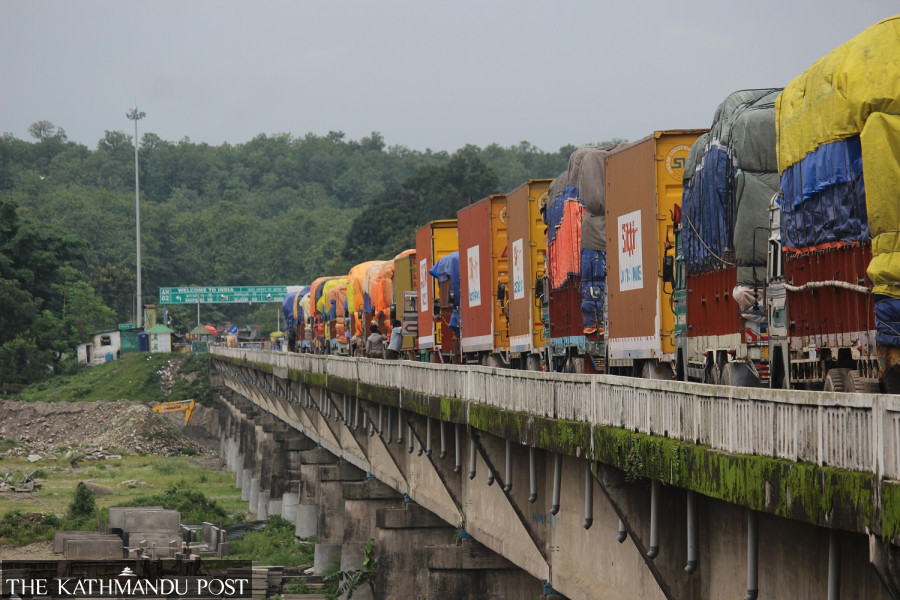National
BBIN motor vehicle agreement protocol ready
BBIN-MVA aims to remove barriers and regulations for bolstering intraregional trade and connectivity.
Anil Giri
A decade after signing the Motor Vehicles Agreement (MVA) for the regulation of passenger, personal and cargo vehicular traffic between Bangladesh, Bhutan, India and Nepal (BBIN), the four South Asian nations have finalised the text of protocol to ensure smooth transport.
The protocol is the first of its kind in South Asia. Besides the motor vehicle agreement, the BBIN countries also envisage interconnected grids for regional energy security. The BBIN-MVA aims to remove barriers and regulations for bolstering intraregional trade and connectivity through the movement of passengers, personal and cargo vehicular traffic.
The BBIN is called a sub-regional cooperation framework within the South Asian Association for Regional Cooperation (Saarc), which is in a state of deep slumber. Saarc has been unable to hold its summit for over a decade due to a longstanding hostility between India and Pakistan.
But some observers said India’s recent decision to rescind critical transshipment facilities granted to Bangladesh that allowed Bangladeshi export cargo to move to third countries via Indian Land Customs Stations (LCSs), ports, and airports may hamper the execution of the MVA between the four nations.
The minister for road transport and bridges of Bangladesh, the minister for information and communications of Bhutan, the minister for road transport and highways and shipping of India, and the minister for physical infrastructure and transport of Nepal had met in Thimphu, Bhutan, on the 15th of June 2015 and signed the BBIN motor vehicle agreement.
The agreement noted that necessary internal formalities for its entry into force had been completed. The agreement would enable seamless movement of vehicles to help with faster and economical exchange of goods and people between their territories. The protocol allows for the launch of a pilot project.
According to the protocol, except Bhutan, three other signatories will allow all kinds of vehicles to ply between them. It introduced three categories—light commercial vehicles (up to 7,500 kilograms), medium commercial vehicles (7,500-12,000 kilograms) and heavy commercial vehicles (above 12,000 kilograms)—under the cargo vehicle movement permits.
In order to finalise the protocol, there were trial runs in 2015 and 2016. It demonstrated that a seamless movement of passengers, personal and cargo vehicular traffic is possible. The cargo trial run was conducted between Kolkata-Dhaka-Agartala route (600km) in November, 2015; between Dhaka and Delhi (1,780km) from 29 August to 5 September 2016; while a passenger bus trial run was done from Dhaka to Kathmandu via India on April 23, 2018.
According to the Asian Development Bank, which supports the execution of the BBIN—MVA, the now proposed trial run routes are Kathmandu-Bhairahawa-Sunauli-Lucknow-Kanpur-New Delhi and Kathmandu-Birgunj-Raxaul-Kolkata between Nepal and India.
The Kathmandu–Kakarvitta–Panitanki–Siliguri-Phulbari–Banglabandha–Mongla/Chattogram route is proposed as a trial route between Nepal, India and Bangladesh.
Officials of the concerned countries met in New Delhi in March 2022 and agreed to formulate a time-bound action plan to execute the motor vehicle agreement; suggested carrying out more trial runs and requested the ADB to support the trial. The bank had later proposed a modality, according to the concept paper of the MVA.
The trial runs were conducted between Bangladesh, India and Nepal or only between two countries. Bhutan has signed the BBIN-MVA and given its consent to the protocol but it did not participate in the trial runs.
The Asian Highway being built by the ADB will be a corridor that will play a vital role for the implementation of the BBIN-MVA.
The ADB also concluded studies on route harmonisation (routes-based origin-destination analysis); route identification; fee determination; cross-border vehicle insurance; and BBIN implication study for Nepal, among others.
Officials said Nepal will have direct access to four Indian ports–Kolkata, Haldia, Visakhapatnam, and Mundra.
The ADB had a presentation in Kathmandu on January 22 with the Nepali private sector stakeholders where diverse Nepali perspectives on the BBIN-MVA were discussed. In the private sector, there are concerns about the ability to compete with Indian companies and the risk of losing the current market share.
Nepali transport companies and crews lack the experience in navigating Indian routes, posing a challenge to cross-border operations. Inadequate road infrastructure and the lack of lab testing facilities at border crossing points (BCP) complicate smooth cross-border transport.
The ADB also pointed out weak coordination among regulatory agencies responsible for border control. Stakeholders foresee a surge in vehicles from India and Bangladesh entering Nepal post-agreement implementation. For Nepali transporters, the high tariff on vehicles leads to elevated costs, undermining their competitiveness.
According to officials from multiple government agencies, all requirements including seeking comments from the stakeholders such as the Federation of Nepalese Chambers of Commerce and Industries have been completed. The FNCCI on March 25 forwarded its nine-point suggestions and recommendations to the Ministry of Foreign Affairs for consideration.
The protocol has provisions for permits; fees and charges; vehicle tracking system; unscheduled halts, accidents and vehicle breakdowns; motor liability insurance; specifications of the vehicles; number and volume of traffic vehicles and other customs issues; cross-border movement of passengers and crews; international transit; terms for establishment of authorised operator branch offices and lists of prohibited/restricted goods.
The protocol also envisions various institutional mechanisms for implementation; and cooperation for investigation and repression of violations; among other issues.
As per its text, signatories to the protocol will establish, within two years from its signing, an electronic platform with appropriate software and hardware for efficient tracking of vehicles plying under the agreement. The nations will establish a common electronic platform for the monitoring of vehicle and cargo movements and the implementation of safety measures.
The crew of the vehicles must be citizens of the signatory countries. They will travel on the basis of valid passports or other documents.
When a visa is required for cross-border travel, the application for a visa by the drivers and crew will be supported by the copy of his/her Crew Identity Card issued in accordance with Annexure-III of the agreement. The applicant must also submit a copy of his/her driving licence. The Crew Identity Card is issued in paper form or as a smart card.
As an institutional arrangement, a permanent National Land Transport Facilitation Committee or a similar body chaired by the secretary and comprising the representatives of all agencies will be set up to coordinate and monitor the implementation of the agreement and the protocol.
A Joint Land Transport Facilitation Committee to monitor and review the implementation of the agreement and serve as a platform for amicable settlement of disputes will be set up.
Likewise, a customs subgroup to regulate the entry and exit of motor vehicles will be established, according to the protocol.
The protocol also has provisions including for suspension, withdrawal, review and amendment of the agreement.
Moreover, the ADB has stressed on the need for awareness on the agreement’s significance among leaders of major political parties in order to build “national consensus”.
The bank will expedite road infrastructure projects and upgrades on the designated BBIN routes to ensure seamless vehicular movement and prepare adequate facilities at border points to implement the agreement with limited permits on feasible routes.




 15.47°C Kathmandu
15.47°C Kathmandu















